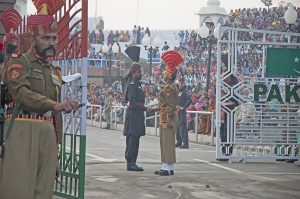Since the February 25 joint ceasefire announcement by India and Pakistan, details about what the future may hold for relations between the archrivals continue to trickle in, with each wave more sensational than the other. On March 22, an Indian media outlet had reported that for the first time in history, Indian armed forces could travel to Pakistan later this year for Shanghai Cooperation Organization (SCO) military exercises. At the same time, another outlet reported earlier on March 23 that the seed of the ceasefire recommitment was laid through secret communications between the spy services of the two countries in 2018.
The Print reported yesterday that Indian forces could travel to Pakistan for the SCO “Pabbi-Antiterror-2021” exercise, to be held at the National Counter Terrorism Center (NCTC) Pabbi, in the Nowshera district in Pakistan’s Khyber Pakhtunkhwa province. The outlet, quoting Chinese news agency Xinhua, said that the decision to hold the exercise was taken at a meeting of SCO’s Regional Anti-Terrorist Structure held at Tashkent, Uzbekistan last week.
“[Indian] Sources in the know remained non-committal about the actual participation of the Indian troops in the joint exercise … saying a final decision was yet to be taken,” The Print added, noting that its sources said India’s National Security Council Secretariat was examining the possibility.
In 2019 the Indian Air Force had carried out airstrikes in the outskirts of Balakot, also in Khyber Pakhtunkhwa, bringing the two nuclear-armed neighbors locked in perennial conflict to the brink of war. The town is about 240 kilometers (or around a four-hour drive) away from Pabbi. India and Chinese forces also clashed in the Galwan Valley in eastern Ladakh last June, leading to the deaths of 20 Indian and at least four Chinese troops.
India’s participation in SCO exercises, in Pakistan or elsewhere, would demonstrate once again the surprising ability of the organization to bring adversaries together under one roof, so to speak. Last year India had skipped a Russia-hosted multilateral military exercise in which both China and Pakistan took part.
Meanwhile details continue to emerge, mostly from Indian media outlets, about how the February 25 ceasefire announcement came to be. Writing for Indian news outlet News18, Praveen Swami – an Indian journalist well known for his reporting on highly sensitive intelligence matters — reported, based on conversations with Indian sources, that “foundations for last month’s ceasefire along the Line of Control (LoC) were laid during a series of one-on-one secret meetings between senior intelligence officers at a London hotel in 2018.”
“Involving a polo-playing General from an aristocratic family, and an ethnic Tamil career intelligence officer responsible for espionage operations targeting Pakistan, the talks began months after Prime Minister Imran Khan took office in 2018,” Swami wrote. According to him, following this first meeting, Indian and Pakistani officials met on at least three other occasions.
Swami’s reporting, on the surface, seems to contradict reports in Foreign Policy and Bloomberg that have suggested that the United Arab Emirates had played a key role in securing the ceasefire. “Lots of foreign capitals have encouraged India-Pakistan peace but the process has been led by the two countries, not external actors,” an Indian source was quoted by Swami as saying. Interestingly, according to him, the Pakistan Army – as an overture of peace – had passed intelligence to India through the U.S. Central Intelligence Agency about impending attacks in India in the summer of 2019 even though the “London channel” established the year before had dried up following the February 2019 Pulwama-Balakot dust-up.
The Indian Express had reported in June 2019 that Pakistan had shared intelligence with both India and the United States about an impending attack in Pulwama district, possibly in Awantipora. “The Pakistanis shared this information regarding the possibility of such an attack with our High Commission in Islamabad. They had also shared this information with the Americans, who too, informed us. So this information has come directly as well as via the Americans to us,” a senior Indian security official was quoted by the newspaper as saying at that time.
Notably, Indian intelligence sources had downplayed this story to Swami at that time, noting that it was an anonymous tip-off to the Indian High Commission and not through intelligence channels. “The heads of the Inter-Services Intelligence and the Research and Analysis Wing have been in periodic contact, so if the Pakistanis wanted to pass on something, they’d just have picked up the phone,” the journalist quoted one of them as saying at that time.
At this stage, it is hard to perfectly reconcile all of the Indian reports emerging about the February 25 ceasefire. But three immediate observations about them are in order. One, the Indian government remains quite invested in the ceasefire recommitment, leading it to almost incessantly provide comments around the exact circumstances leading up to it to the media. Two, it seems that a multitude of channels and actors, including external ones, were in one way or the other involved in securing it, even though the process itself was punctuated by several setbacks. Because of that, the chances of the ceasefire announcement amounting to something more durable remains higher than initially expected. Third and finally, in the deeply murky world of South Asian intelligence and security affairs, the “truth” told often depends on who is doing the telling — and why and when.

































